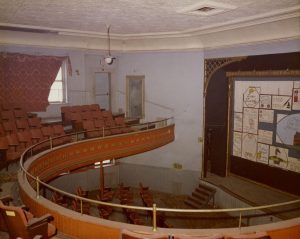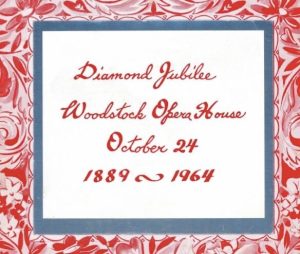The History of WFAA
The Woodstock Fine Arts Association story fittingly begins with adults and young people who shared a passion for the arts.
Let’s step back to 1959, the middle of the past century.
In the town of Woodstock, Illinois, six high school students presented Esther Wanieck, a guiding light in Woodstock’s theater arts scene, with an idea—let’s bring live performances back to the Woodstock Opera House. Esther began holding theater workshops, transforming high school and college students into good actors, producers, directors and set designers.
But the Opera House, built in 1889 in an architectural style known as Steamboat Gothic, had fallen into serious disrepair. The seats and seat risers were gone, the electrical system was faulty, and everything was covered in dust. Pigeons that had entered through holes in the roof, seeking shelter from the cold, died inside.
The small group soon grew to some 25 students and adults. Embracing the idea of saving the Opera House, they called themselves the Junior Civic Arts League. They worked all summer, scrubbing floors, walls and windows. They laundered draperies, repaired the electrical system and painted the proscenium. Their efforts to restore the original floor completed, they decided to put on a play.
With material and financial support from the community, they staged You Can’t Take it With You. Dedicated volunteers had to clear pigeon droppings from seats before shows began. Safety was of such concern that firemen stood by during performances at a cost of six dollars per shift.
Efforts to upgrade the Opera House continued. The Junior Civic Arts League asked for and received seats from the old Greater Northern Theater in Chicago. When they learned that Chicago’s Eighth Street Theater was to be torn down, they salvaged lighting equipment and drapes. A series of one-act plays followed: Happy Journey, Riders to the Sea, and Bertha, the Bartender’s Beautiful Baby.
By 1961 concern was growing that interest in saving the Opera House had ebbed. Some voices were even calling for the historic building to be demolished and replaced with a parking lot.
In November 1961 Woodstock Fine Arts Association was formed to provide year-round programming and organizational support for the restoration campaign. With long-term vision, the founders expressed WFAA’s mission in broad terms. The group would promote cultural and educational activities for the enjoyment of all ages. Jim Hecht, a local attorney and jazz musician, was WFAA’s first president, and Junior Civic Arts League members became leaders.
The year 1964 saw the debut of the Creative Living Speaker Series, the brainchild of another early leader, Helen Wright. After the lectures, patrons met over coffee and the conversation frequently centered on saving the Opera House. Friendships and community spirit were forged. Action followed.
In 1964 WFAA also began awarding scholarships to graduating high school seniors in McHenry County who excelled in the arts. The first recipient was David Huffman from Woodstock High School. Through 2022 WFAA has awarded over $183,000.
Following the Diamond Jubilee, WFAA committed to the restoration of the Opera House, and for the next seven years continued to provide programming, leadership, fundraising and devotion to the effort. In addition to the Creative Living Speaker Series, there were puppet shows, a fine arts chorale, membership teas and orchestral programs.
The 1970s
In 1972, a Ford Foundation grant made it possible to obtain professional counsel on the direction for the future of the Opera House. Fundraising for the restoration began in earnest.
In a 1972 letter, George Izenour, head of the Theater Architectural Department at Yale University and one of the architectural historians who had visited Woodstock to evaluate the Opera House, commended members for their “dogged persistence” in saving the Opera House, which was “probably the only extant example of steamboat Gothic Architecture left anywhere on dry land.” He described the building as “a living artifact of theatrical Americana.”
The following year, WFAA members celebrated, hosting a dedication gala under the direction of Mayor Joe Gitlin.
These original stencils were uncovered during restoration of the Opera House, reproduced, and are visible today in the elaborate interior.





